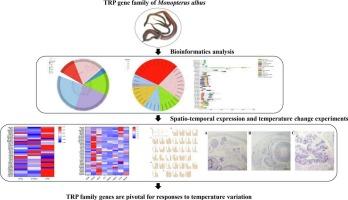Phylogenetic analysis, tissue expression, and response to temperature variation of TRP genes in Monopterus albus
IF 2.2
2区 生物学
Q4 BIOCHEMISTRY & MOLECULAR BIOLOGY
Comparative Biochemistry and Physiology D-Genomics & Proteomics
Pub Date : 2025-08-19
DOI:10.1016/j.cbd.2025.101616
引用次数: 0
Abstract
The transient receptor potential (TRP) channels are essential in vertebrate sensory nervous systems, responding to various stimuli, including changes in environmental temperature. A recent study suggested that Trpv4 may be involved in temperature-induced sex reversal of Monopterus albus, a hermaphroditic and economically farmed fish. In this study, we obtained a total of 36 TRP genes of M. albus from 6 TRP subfamilies, and their basic physiological and biochemical characteristics were characterized. We conducted statistical and cluster analyses on 336 TRP genes from 10 species and found that they all contained the TRPA, TRPC, TRPM, TRPV, MCOLN, PKD subfamilies. In particular, Misgurnus anguillicaudatus and Paramisgurnus dabryanus also had the TRPN subfamily. In addition, we detected the expression of the TRP genes of M. albus in different sexes, different tissues and different temperatures by RT-qPCR. The results showed the expression of TRP genes was different between sexes and had tissue specificity. Most TRP genes are expressed in males (sex) or in the gonads and heart (tissue). Most importantly, we found that there are four response patterns of the TRP genes to temperature changes. Among them, most genes (20/36) are sensitive to both high and low temperatures. We detected that Trpc1, a gene sensitive only to high temperature, was mainly localized to early oocytes or seminal vesicles in gonads of different sexes, and Trpc1 was under positive selection. Our findings will provide essential data for future investigations of the role of the TRP gene family in temperature-induced sex reversal of M. albus or the role in adapting to other environmental changes.

黄鳝TRP基因的系统发育分析、组织表达及对温度变化的响应
瞬时受体电位(TRP)通道在脊椎动物感觉神经系统中是必不可少的,响应各种刺激,包括环境温度的变化。最近的一项研究表明,Trpv4可能参与温度诱导的黄鳝性别逆转,黄鳝是一种雌雄同体的经济养殖鱼类。本研究共获得了白曲霉6个TRP亚家族的36个TRP基因,并对其基本生理生化特性进行了表征。我们对来自10个物种的336个TRP基因进行了统计和聚类分析,发现它们都包含TRPA、TRPC、TRPM、TRPV、MCOLN、PKD亚家族。特别值得一提的是,鳗鲡(Misgurnus anguillicaudatus)和大鳞副龙(parisgurnus dabryanus)也具有TRPN亚家族。此外,我们还利用RT-qPCR检测了不同性别、不同组织和不同温度条件下白念珠菌TRP基因的表达。结果表明,TRP基因的表达存在性别差异,且具有组织特异性。大多数TRP基因在男性(性别)或性腺和心脏(组织)中表达。最重要的是,我们发现TRP基因对温度变化有四种响应模式。其中,大多数基因(20/36)对高温和低温都敏感。我们发现Trpc1是一种仅对高温敏感的基因,主要定位于不同性别性腺的早期卵母细胞或精囊中,并且Trpc1处于正选择状态。我们的研究结果将为进一步研究TRP基因家族在温度诱导的白螺旋体性别逆转中的作用或在适应其他环境变化中的作用提供必要的数据。
本文章由计算机程序翻译,如有差异,请以英文原文为准。
求助全文
约1分钟内获得全文
求助全文
来源期刊
CiteScore
5.10
自引率
3.30%
发文量
69
审稿时长
33 days
期刊介绍:
Comparative Biochemistry & Physiology (CBP) publishes papers in comparative, environmental and evolutionary physiology.
Part D: Genomics and Proteomics (CBPD), focuses on “omics” approaches to physiology, including comparative and functional genomics, metagenomics, transcriptomics, proteomics, metabolomics, and lipidomics. Most studies employ “omics” and/or system biology to test specific hypotheses about molecular and biochemical mechanisms underlying physiological responses to the environment. We encourage papers that address fundamental questions in comparative physiology and biochemistry rather than studies with a focus that is purely technical, methodological or descriptive in nature.

 求助内容:
求助内容: 应助结果提醒方式:
应助结果提醒方式:


